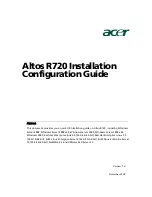
Model: MTS200 (1U)
Doc. Ref. no. : - m08/om/201
Issue no.: 03
Page 11 of 195
User’s Manual
3 GPS Fundamentals
mas
TER
T-Sync
Model MTS200 device is a GPS/GNSS based receiver clock device which provides
accurate time output with 1PPS signal. Satellite Navigation system is a system of satellites that provide
autonomous geo-spatial positioning with global coverage. It allows small electronic receivers to determine
their location (longitude, latitude, and altitude) to high precision (within a few meters) using time
signals transmitted along a line of sight by radio from satellites
.
GNSS is a satellite navigation system that
is used multiple navigation systems mainly GPS and GLONASS. GNSS also include satellite navigation
systems of SBAS, QZSS, Galileo systems etc.
GPS satellite navigation system is maintained by United States of America since 1994 which consists of
at-least 24 operational satellites out of 32 satellites in six orbital planes orbiting at an altitude of
approximately 20,200 km. In typical GPS operation, four or more satellites must be visible to obtain an
accurate result. Satellite-based navigation systems use a version of triangulation to locate the user,
through calculations involving information from a number of satellites.
Figure 3-1
The Basis of GPS
If one considers Figure 1 which shows a flat plane. X and Y are two known fixed points on the plane. P is
an unknown point. If the distances PX and PY can be measured, then the position of point P can be
calculated. Actually there is an ambiguity in that p
oint P‟ would also fit the measurements. This can be
resolved if the position of a third fixed point Z is known since PZ is different to P‟Z. This can be summed
up by saying that the unknown point P lies at the intersection of three circles based on the known points
X, Y and Z.
When the plane becomes three dimensional spaces, the circles become spheres. The intersection of two
sphere is a circle, and the intersection of three spheres is a pair of points analogous to the points P and
P‟ of the flat plane case. As for the flat plane case a measurement from an extra fixed point is required to
absolutely resolve the ambiguity, although in many cases the ambiguous point would be below the
surface of the world. Thus to achieve the objective, GPS must provide accurate measurement of distance
from the unknown location of the receiver to 4 known points.
GLONASS based satellite navigation system is maintained by Russia, a fully functional navigation
constellation in 1995. After the collapse of the Soviet Union, it fell into disrepair, leading to gaps in
coverage and only partial availability. It was recovered and fully restored in 2011. It provides an
alternative to Global Positioning System (GPS) and is the second alternative navigational system in
operation with global coverage and of comparable precision.
A fully operational GLONASS constellation consists of 24 satellites, with 21 used for transmitting signals
and three for in-orbit spares, deployed in three orbital planes. The three orbital planes' ascending nodes
are separated by 120° with each plane containing eight equally spaced satellites. The orbits are roughly












































